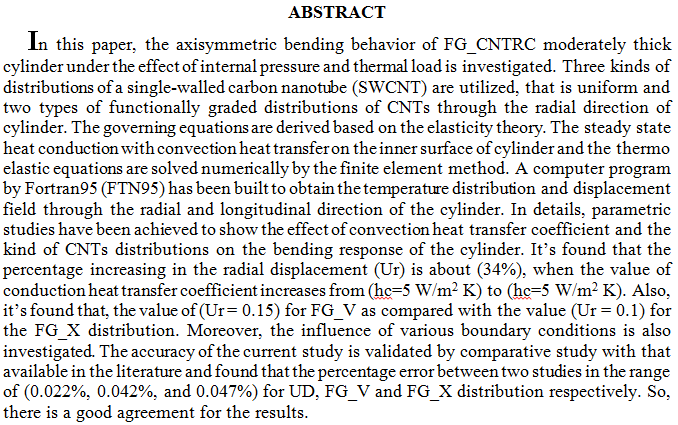
Investigation of the adsorption of Chromium (VI) on Fe3O4 is carried out using batch scale experiments according to statistical design using a software program minitab17 (Box-Behnken design). Experiments were carried out as per Box-Behnken design with four input parameters such as pH (2-8), initial concentration (50–150mg/L), adsorbent dosage (0.05–0.3 g) and time of adsorption (10–60min). The better conditions were showed at pH: 2; contact time: 60 min; chromium concentration: 50 mg/L and magnetite dosage: 0.3 g for maximum Chromium (VI) removal of (98.95%) with an error of 1.08%. The three models (Freundlich, Langmuir, and Temkin) were fitted to experimental data, Langmuir isotherm has bette
... Show More (9)
(9)
Current study was carried out to determine the adsorption ability of the Multiwall carbon nanotubes (MWCNTs) by adsorption Malachite Green dye from an aqueous solution. Crystal structure of the materials was measured using powder X-rays diffraction (PXRD), UV–Vis diffuse reflectance and specific surface area (BET). Many parameters that affecting the adsorption process such as contact time, pH, adsorbent dosage, initial dye concentration and temperature were studied. The outcome showed that an increasing occurred in the adsorbent dosage and the rate of dye removal, and the best efficiency for Malachite Green dye removal was amounted 99. 11 %. The results were obtained at optimal reaction conditions were pH = 5.5, cata
... Show MoreIn this work, electron number density calculated using Matlab program code with the writing algorithm of the program. Electron density was calculated using Anisimov model in a vacuum environment. The effect of spatial coordinates on the electron density was investigated in this study. It was found that the Z axis distance direction affects the electron number density (ne). There are many processes such as excitation; ionization and recombination within the plasma that possible affect the density of electrons. The results show that as Z axis distance increases electron number density decreases because of the recombination of electrons and ions at large distances from the target and the loss of thermal energy of the electrons in high distance
... Show MoreIn this work, diamond-like carbon (DLC) thin films were prepared from Cyclohexane. Thin films were deposited on quartz substrate by atmospheric pressure Argon plasma jet system. The plasma jet system was applying high voltage sinusoidal waves of frequency 28 kHz and potential difference of 7.5kV peak to peak across the electrodes. The effect of annealing at 400, 500 and 600 °C under vacuum for two hours on optical properties and structural properties of the DLC thin films were investigated. This effect was clarified by X-ray diffraction (XRD), FTIR, UV-Visible absorption, Scanning Electron Microscopy (SEM) and Raman Spectroscopy. The X-ray diffraction patterns for the annealing DLC thin films show two broad peaks at 2θ, 26.62° and 51.58
... Show More (2)
(2)
 (2)
(2)
In this work, electron number density calculated using Matlab program code with the writing algorithm of the program. Electron density was calculated using Anisimov model in a vacuum environment. The effect of spatial coordinates on the electron density was investigated in this study. It was found that the Z axis distance direction affects the electron number density (ne). There are many processes such as excitation; ionization and recombination within the plasma that possible affect the density of electrons. The results show that as Z axis distance increases electron number density decreases because of the recombination of electrons and ions at large distances from the target and the loss of thermal energy of the electrons in
... Show MoreThis study includes adding chemicals to gypseous soil to improve its collapse characteristics. The collapse behavior of gypseous soil brought from the north of Iraq (Salah El-Deen governorate) with a gypsum content of 59% was investigated using five types of additions (cement dust, powder sodium meta-silicate, powder activated carbon, sodium silicate solution, and granular activated carbon). The soil was mixed by weight with cement dust (10, 20, and 30%), powder sodium meta-silicate (6%), powder activated carbon (10%), sodium silicate solution (3, 6, and 9%), and granular activated carbon (5, 10, and 15%). The collapse potential is reduced by 86, 71, 43, 37, and 35% when 30% cement dust, 6% powder sodium meta-silicate, 10% powder activated
... Show More (4)
(4)
 (3)
(3)
Alpha shape theory for 3D visualization and volumetric measurement of brain tumor progression using magnetic resonance images
 (28)
(28)
 (23)
(23)
Using orbit- motion limited theory, as the exact theory in calculating the ion and electron current in dusty plasma, the variations of charge number on a dust grain in Ar-plasma are studied by changing various charging parameters. Most of dependences of charge number on plasma parameters in this paper take into account the close packed effect.
Background: One of the most common complications of dentures is its ability to fracture, so the aim of this study was to reinforce the high impact denture base with carbon nanotubes in different concentrations to improve the mechanical and physical properties of the denture base. Materials and methods: Three concentrations of carbon nanotubes was used 0.5%, 1%, 1.5% in a pilot study to see the best values regarding transverse strength, impact, hardness and roughness test, 1 wt% was the best concentration, so new samples for control group and 1wt% carbon nanotubes and the previous tests were of course repeated. Results: There was a significant increase in impact strength and transverse strength when we add carbon nanotubes in 1wt%, compared
... Show More